Featured Articles
Mini-blogs on Kovalev, Mayweather-Pacquiao and PBC on NBC

Mini-blogs on Kovalev, Mayweather-Pacquiao and Premier Boxing Champions
Bloggers gonna blog. I think that’s a saying. If not, it might should be. Anyway, here’s a smattering of thoughts on Sergey Kovalev, Mayweather-Pacquiao and Al Hayon’s Premier Boxing Champions.
Don’t Ask Sergey Kovalev About Mayweather-Pacquiao
The running debate in boxing today is who is scarier: undefeated middleweight monster Gennady Golovkin or light heavyweight destroyer Sergey Kovalev. I’ve spoken with both men a handful of times, the latter in person at least twice.
While I wouldn’t want to step in the ring (or a dark alley) against either man, I have to say that Kovalev just seems the scarier fighter to me. I have several reasons, but I’ll hit the important ones at a high level here.
First, Kovalev just seems meaner. That’s not to say he’s not polite to fans and media. He is. Or even that he’s actually mean. Maybe he’s not. But there’s something I see beneath his menacing eyes that tells me he’d rather be bashing skulls with his fists than doing mundane things like smiling and talking to people.
Second, he’s the one fighter I’ve met in person (and I’ve met plenty) who while I was interviewing him, I felt the distinct impression that he absolutely hated my guts. No matter how much he smiled and nodded or how many nice the things he said to me, I always came away from the encounter thinking that the whole time my gums are flapping at him that he’s pondering in his mind what my blood looks like.
None of these things may be true, mind you. It’s just the vibe I get.
But probably the best interview I ever had was Kovalev, and it was precisely because he was so surly with me during it that it made for some really good copy. Already not the type to enjoy chatting with media people (especially those of us who aren’t big-timers like Dan Rafael or Chris Mannix), Kovalev was in the midst of losing the necessary amount of weight required to make his 175-pound contract limit for his bout against Blake Caparello.
“How are you today,” I asked to open the call.
“Hungry,” he scowled back at me.
That set the tone for the rest of the interview. He was hungry and angry and I got the sense he really didn’t like doing interviews so his answers were short and his voice was gruff. All the while, of course, I could see in my mind images of him chopping light heavyweights down as if his arms were axes.
He was much more chipper when I talked to him last week. Maybe the birth of his son has softened the big lug up a bit. Maybe he’s grown accustomed to the media junket all HBO boxing stars are put through. Maybe he’s grown to like me. At least that’s what I thought until I closed the call by asking him the obligatory Floyd Mayweather vs. Manny Pacquiao question.
A long silence followed. His manager, Egis Klimas (who I get the same kind of vibe from by the way), proceeded to translate it for Kovalev in case he had trouble picking it up himself. The only words I understood among the hodgepodge of what I assume to be Russian are “Pacquiao” and “Mayweather.”
Silence again.
“Um…,” Kovalev says, emitting a long sigh in the process.
More silence.
“I don’t like to do predictions,” Kovalev finally says to me. I can only imagine what might be going through his mind as he proceeds with the rest of his answer. He’s talking Mayweather-Pacquiao, but I keep thinking he’s wondering what my spine would feel like in his hand.
“The fight is one the boxing world has waited for…I think it will be a war of mind: who is smarter will win.”
There is another long period of silence, and then we both begin to speak, talking over each other. Obviously, if two people begin speaking at the same time and one of them is Sergey Kovalev, the other is, by default, interrupting.
“Do you think it will be a good fight?” I clumsily ask over whatever it was he was about to say.
Silence. Then more translation.
“Yes. I think it will be interesting fight. Who wins? I don’t know. I’m not going to say who will win.”
Fair enough, Sergey.
You Can Ask Jean Pascal and Bryant Jennings About Mayweather-Pacquiao (But I Already Did)
I also talked to Kovalev’s March 14 opponent, Jean Pascal, and undefeated heavyweight Bryant Jennings, who faces world champ Wladimir Klitschko on April 25. Both of them see close Mayweather wins over Pacquiao.
“Five years ago, I would have said Mayweather easily,” said Pascal. “But now, time is starting to catch up to Floyd. The fight will be much closer than it was five years ago, but I have no choice but to go with Floyd because Floyd is the man right now.”
Pascal continued.
“It seems to me like it. It’s not because of one fight that age is starting to catch up. If we see it again versus Pacquiao, we’ll know for sure. But in his last fight, he wasn’t moving the way he used to move. People are starting to say that but who knows? We’ll see on May 2.”
Still, Pascal likes Pacquiao to give Mayweather a stern test.
“Definitely, Pacquiao can give him his toughest test because Pacquiao is strong. Pacquiao is fast. I think right now this is the biggest fight for Floyd and the biggest fight for the sport.”
Jennings had similar thoughts.
“I think Mayweather is going to win,” said Jennings. “Skill for skill, I think Mayweather will win. But there are some things I’ve seen in Mayweather’s last fight that Pacquiao might be able to capitalize on. But Floyd was going through a lot of things in his last fight. I’m hoping he learned his lesson. All that stuff can play a part. A lot of things probably got to him that he probably learned now that he shouldn’t have let get to him.”
Jennings also believes Pacquiao will give Mayweather a good fight.
“He probably can. It’s going to be a great fight. I’m pretty hyped about it. I’m a Mayweather fan, but I’m also a Pacquiao fan. He followed me back on Instagram so…”
We had a good laugh about the last bit.
A Note on Al Haymon’s Premier Boxing Champions
My Twitter timeline was almost universal in praise of Al Haymon’s Premier Boxing Champions. The inaugural show kicked off Saturday night on NBC. Boxing needs more skeptics. Here’s why.
First, people seem to be buying into PBC for two main reasons. First, they want to see boxing on network television. That’s best for everyone. It means more free shows for fans and better job security and growth potential for the boxing media. Second, the PBC has gone out of its way to promote itself as a change for the sport, something both boxing fans and media have long pined for. The status quo is not ideal.
Here’s criticism on both.
First, for PBC to be successful, it needs to draw sponsors. As of now, all Haymon has done is bought airtime on NBC and other networks to promote his fighters. So what’s happened so far is Haymon has set a precedent where networks might now expect promoters to pay them to put boxing on TV. Let’s say sponsors never come and PBC has to fold up shop in a year. Will boxing ever find its way onto network television again? Both Main Events and Golden Boy Promotions have had fights air on network television in recent years. If Haymon fails, will it ever happen again? Is the risk worth the potential reward?
Second, PBC is seen by some as a breath of fresh air, a change for the sport of boxing. But is it? Haymon has been in boxing longer than I’ve been a boxing writer. His involvement in the sport has been good for his fighters but potentially less so for the overall health of boxing. Many fights that could have and should have been made over the years did not come to fruition because (at least in part) Haymon did not want the bouts to happen. He’s shown a consistent inability to make the fights most fans most want to see. Leo Santa Cruz is a perfect example of a Haymon fighter who has not faced anything but cupcake opposition since bursting onto the scene as a fan favorite two years ago.
The simplest way to put it is this: Haymon isn’t really a breath of fresh air, and the innovations of PBC seem more veneer at this point than actual substance. Yes, they’ve rid boxing of fighter entourages during ring walks and the fetishism of title belts. Yes, they paid off NBC so fights can be on network television. Yes, they hired a bunch of celebrities to call the action. And do not get me wrong, all of it could turn into something really good for boxing.
But until further notice, the PBC is still run by the same people who gave us one of the more disappointing years of Showtime fights in recent memory. They’re the same people who let Danny Garcia butcher lightweight Rod Salka in a farce of boxing contest. They’re the same entity that Freddie Roach claims is currently paying off potential sparring partners for Manny Pacquiao so the Haymon fighter, Floyd Mayweather, has as large an advantage as possible when the two meet on May 2 (even though someone claiming to be “The Best Ever” shouldn’t need such silly shenanigans).
The final point is this: The only way PBC is truly successful in changing the sport as a whole will be by destroying and rebuilding it. If boxing is to make all the right fights, the ones fight fans want, then PBC must become the only game in town. That means other promoters go away or become so small that they don’t really matter and PBC becomes boxing’s version of UFC. That might not be a bad thing. But it might not be good either. And it hasn’t happened yet. All the PBC is at present is a sparkly new enterprise, one that could become the future of boxing or ruin it altogether by creating yet another faction in this already fractured sport.
Criticism of such an exploit isn’t just fair and valid right now. It’s absolutely necessary.
WATCH RELATED VIDEOS ON BOXINGCHANNEL.TV
Featured Articles
Avila Perspective, Chap. 326: Top Rank and San Diego Smoke
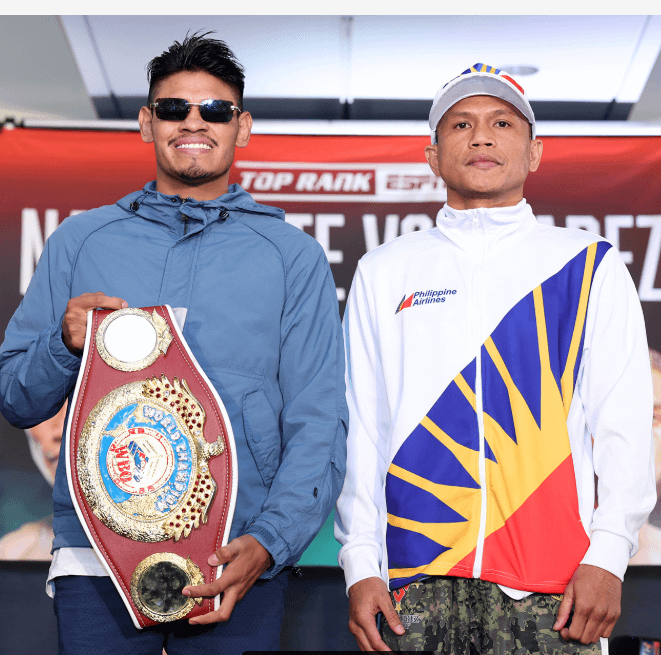
Avila Perspective, Chap. 326: Top Rank and San Diego Smoke
Years ago, I worked at a newsstand in the Beverly Hills area. It was a 24-hour a day version and the people that dropped by were very colorful and unique.
One elderly woman Eva, who bordered on homeless but pridefully wore lipstick, would stop by the newsstand weekly to purchase a pack of menthol cigarettes. On one occasion, she asked if I had ever been to San Diego?
I answered “yes, many times.”
She countered “you need to watch out for San Diego Smoke.”
This Saturday, Top Rank brings its brand of prizefighting to San Diego or what could be called San Diego Smoke. Leading the fight card is Mexico’s Emanuel Navarrete (39-2-1, 32 KOs) defending the WBO super feather title against undefeated Filipino Charly Suarez (18-0, 10 KOs) at Pechanga Arena. ESPN will televise.
This is Navarrete’s fourth defense of the super feather title.
The last time Navarrete stepped in the boxing ring he needed six rounds to dismantle the very capable Oscar Valdez in their rematch. One thing about Mexico City’s Navarrete is he always brings “the smoke.”
Also, on the same card is Fontana, California’s Raymond Muratalla (22-0, 17 KOs) vying for the interim IBF lightweight title against Russia’s Zaur Abdullaev (20-1, 12 KOs) on the co-main event.
Abdullaev has only fought once before in the USA and was handily defeated by Devin Haney back in 2019. But that was six years ago and since then he has knocked off various contenders.
Muratalla is a slick fighting lightweight who trains at the Robert Garcia Boxing Academy now in Moreno Valley, Calif. It’s a virtual boot camp with many of the top fighters on the West Coast available to spar on a daily basis. If you need someone bigger or smaller, stronger or faster someone can match those needs.
When you have that kind of preparation available, it’s tough to beat. Still, you have to fight the fight. You never know what can happen inside the prize ring.
Another fighter to watch is Perla Bazaldua, 19, a young and very talented female fighter out of the Los Angeles area. She is trained by Manny Robles who is building a small army of top female fighters.
Bazaldua (1-0, 1 KO) meets Mona Ward (0-1) in a super flyweight match on the preliminary portion of the Top Rank card. Top Rank does not sign many female fighters so you know that they believe in her talent.
Others on the Top Rank card in San Diego include Giovani Santillan, Andres Cortes, Albert Gonzalez, Sebastian Gonzalez and others.
They all will bring a lot of smoke to San Diego.
Probox TV
A strong card led by Erickson “The Hammer” Lubin (26-2, 18 KOs) facing Ardreal Holmes Jr. (17-0, 6 KOs) in a super welterweight clash between southpaws takes place on Saturday at Silver Spurs Arena in Kissimmee, Florida. PROBOX TV will stream the fight card.
Ardreal has rocketed up the standings and now faces veteran Lubin whose only losses came against world titlists Sebastian Fundora and Jermell Charlo. It’s a great match to decide who deserves a world title fight next.
Another juicy match pits Argentina’s Nazarena Romero (14-0-2) against Mexico’s Mayelli Flores (12-1-1) in a female super bantamweight contest.
Nottingham, England
Anthony Cacace (23-1, 8 KOs) defends the IBO super featherweight title against Leigh Wood (28-3, 17 KOs) in Wood’s hometown on Saturday at Nottingham Arena in Nottingham, England. DAZN will stream the Queensberry Promotions card.
Ireland’s Cacace seems to have the odds against him. But he is no stranger to dancing in the enemy’s lair or on foreign territory. He formerly defeated Josh Warrington in London and Joe Cordina in Riyadh in IBO title defenses.
Lampley at Wild Card
Boxing telecaster Jim Lampley will be signing his new book It Happened! at the Wild Card Boxing gym in Hollywood, Calif. on Saturday, May 10, beginning at 2 p.m. Lampley has been a large part of many of the greatest boxing events in the past 40 years. He and Freddie Roach will be at the signing.
Fights to Watch (All times Pacific Time)
Sat. DAZN 11 a.m. Anthony Cacace (23-1) vs Leigh Wood (28-3).
Sat. PROBOX.tv 3 p.m. Erickson Lubin (26-2) vs Ardreal Holmes Jr. (17-0).
Sat. ESPN 7 p.m. Emanuel Navarrete (39-2-1) vs Charly Suarez (18-0); Raymond Muratalla (22-0) vs Zaur Abdullaev (20-1).
Photo credit: Mikey Williams / Top Rank
To comment on this story in the Fight Forum CLICK HERE
Featured Articles
“Breadman” Edwards: An Unlikely Boxing Coach with a Panoramic View of the Sport
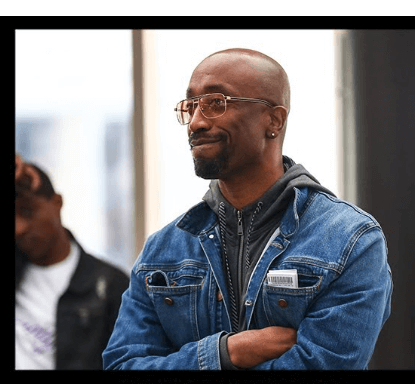
Stephen “Breadman” Edwards’ first fighter won a world title. That may be some sort of record.
It’s true. Edwards had never trained a fighter, amateur or pro, before taking on professional novice Julian “J Rock” Williams. On May 11, 2019, Williams wrested the IBF 154-pound world title from Jarrett Hurd. The bout, a lusty skirmish, was in Fairfax, Virginia, near Hurd’s hometown in Maryland, and the previously undefeated Hurd had the crowd in his corner.
In boxing, Stephen Edwards wears two hats. He has a growing reputation as a boxing coach, a hat he will wear on Saturday, May 31, at Mandalay Bay in Las Vegas when the two fighters that he currently trains, super middleweight Caleb Plant and middleweight Kyrone Davis, display their wares on a show that will air on Amazon Prime Video. Plant, who needs no introduction, figures to have little trouble with his foe in a match conceived as an appetizer to a showdown with Jermall Charlo. Davis, coming off his career-best win, an upset of previously undefeated Elijah Garcia, is in tough against fast-rising Cuban prospect Yoenli Hernandez, a former world amateur champion.
Edwards’ other hat is that of a journalist. His byline appears at “Boxing Scene” in a column where he answers questions from readers.
It’s an eclectic bag of questions that Breadman addresses, ranging from his thoughts on an upcoming fight to his thoughts on one of the legendary prizefighters of olden days. Boxing fans, more so than fans of any other sport, enjoy hashing over fantasy fights between great fighters of different eras. Breadman is very good at this, which isn’t to suggest that his opinions are gospel, merely that he always has something provocative to add to the discourse. Like all good historians, he recognizes that the best history is revisionist history.
“Fighters are constantly mislabled,” he says. “Everyone talks about Joe Louis’s right hand. But if you study him you see that his left hook is every bit as good as his right hand and it’s more sneaky in terms of shock value when it lands.”
Stephen “Breadman” Edwards was born and raised in Philadelphia. His father died when he was three. His maternal grandfather, a Korean War veteran, filled the void. The man was a big boxing fan and the two would watch the fights together on the family television.
Edwards’ nickname dates to his early teen years when he was one of the best basketball players in his neighborhood. The derivation is the 1975 movie “Cornbread, Earl and Me,” starring Laurence Fishburne in his big screen debut. Future NBA All-Star Jamaal Wilkes, fresh out of UCLA, plays Cornbread, a standout high school basketball player who is mistakenly murdered by the police.
Coming out of high school, Breadman had to choose between an academic scholarship at Temple or an athletic scholarship at nearby Lincoln University. He chose the former, intending to major in criminal justice, but didn’t stay in college long. What followed were a succession of jobs including a stint as a city bus driver. To stay fit, he took to working out at the James Shuler Memorial Gym where he sparred with some of the regulars, but he never boxed competitively.
Over the years, Philadelphia has harbored some great boxing coaches. Among those of recent vintage, the names George Benton, Bouie Fisher, Nazeem Richardson, and Bozy Ennis come quickly to mind. Breadman names Richardson and West Coast trainer Virgil Hunter as the men that have influenced him the most.
We are all a product of our times, so it’s no surprise that the best decade of boxing, in Breadman’s estimation, was the 1980s. This was the era of the “Four Kings” with Sugar Ray Leonard arguably standing tallest.
Breadman was a big fan of Leonard and of Leonard’s three-time rival Roberto Duran. “I once purchased a DVD that had all of Roberto Duran’s title defenses on it,” says Edwards. “This was a back before the days of YouTube.”
But Edwards’ interest in the sport goes back much deeper than the 1980s. He recently weighed in on the “Pittsburgh Windmill” Harry Greb whose legend has grown in recent years to the point that some have come to place him above Sugar Ray Robinson on the list of the greatest of all time.
“Greb was a great fighter with a terrific resume, of that there is no doubt,” says Breadman, “but there is no video of him and no one alive ever saw him fight, so where does this train of thought come from?”
Edwards notes that in Harry Greb’s heyday, he wasn’t talked about in the papers as the best pound-for-pound fighter in the sport. The boxing writers were partial to Benny Leonard who drew comparisons to the venerated Joe Gans.
Among active fighters, Breadman reserves his highest praise for Terence Crawford. “Body punching is a lost art,” he once wrote. “[Crawford] is a great body puncher who starts his knockouts with body punches, but those punches are so subtle they are not fully appreciated.”
If the opening line holds up, Crawford will enter the ring as the underdog when he opposes Canelo Alvarez in September. Crawford, who will enter the ring a few weeks shy of his 38th birthday, is actually the older fighter, older than Canelo by almost three full years (it doesn’t seem that way since the Mexican redhead has been in the public eye so much longer), and will theoretically be rusty as 13 months will have elapsed since his most recent fight.
Breadman discounts those variables. “Terence is older,” he says, “but has less wear and tear and never looks rusty after a long layoff.” That Crawford will win he has no doubt, an opinion he tweaked after Canelo’s performance against William Scull: “Canelo’s legs are not the same. Bud may even stop him now.”
Edwards has been with Caleb Plant for Plant’s last three fights. Their first collaboration produced a Knockout of the Year candidate. With one ferocious left hook, Plant sent Anthony Dirrell to dreamland. What followed were a 12-round setback to David Benavidez and a ninth-round stoppage of Trevor McCumby.
Breadman keeps a hectic schedule. From Monday through Friday, he’s at the DLX Gym in Las Vegas coaching Caleb Plant and Kyrone Davis. On weekends, he’s back in Philadelphia, checking in on his investment properties and, of greater importance, watching his kids play sports. His 14-year-old daughter and 12-year-old son are standout all-around athletes.
On those long flights, he has plenty of time to turn on his laptop and stream old fights or perhaps work on his next article. That’s assuming he can stay awake.
To comment on this story in the Fight Forum CLICK HERE
Featured Articles
Arne’s Almanac: The Good, the Bad, and the (Mostly) Ugly; a Weekend Boxing Recap and More
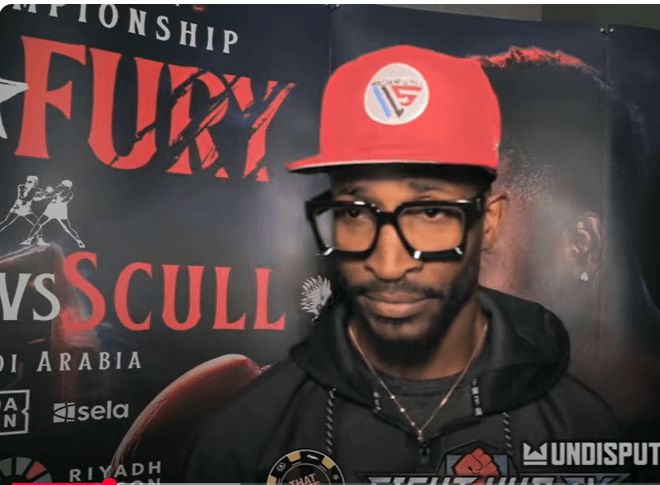
Arne’s Almanac: The Good, the Bad, and the (Mostly) Ugly; a Weekend Boxing Recap and More
It’s old news now, but on back-to-back nights on the first weekend of May, there were three fights that finished in the top six snoozefests ever as measured by punch activity. That’s according to CompuBox which has been around for 40 years.
In Times Square, the boxing match between Devin Haney and Jose Carlos Ramirez had the fifth-fewest number of punches thrown, but the main event, Ryan Garcia vs. Rolly Romero, was even more of a snoozefest, landing in third place on this ignoble list.
Those standings would be revised the next night – knocked down a peg when Canelo Alvarez and William Scull combined to throw a historically low 445 punches in their match in Riyadh, Saudi Arabia, 152 by the victorious Canelo who at least pressed the action, unlike Scull (pictured) whose effort reminded this reporter of “Cat on a Hot Tin Roof” – no, not the movie starring Paul Newman, just the title.
CompuBox numbers, it says here, are best understood as approximations, but no amount of rejiggering can alter the fact that these three fights were stinkers. Making matters worse, these were pay-per-views. If one had bundled the two events, rather than buying each separately, one would have been out $90 bucks.
****
Thankfully, the Sunday card on ESPN from Las Vegas was redemptive. It was just what the sport needed at this moment – entertaining fights to expunge some of the bad odor. In the main go, Naoya Inoue showed why he trails only Shohei Ohtani as the most revered athlete in Japan.
Throughout history, the baby-faced assassin has been a boxing promoter’s dream. It’s no coincidence that down through the ages the most common nickname for a fighter – and by an overwhelming margin — is “Kid.”
And that partly explains Naoya Inoue’s charisma. The guy is 32 years old, but here in America he could pass for 17.
Joey Archer
Joey Archer, who passed away last week at age 87 in Rensselaer, New York, was one of the last links to an era of boxing identified with the nationally televised Friday Night Fights at Madison Square Garden.
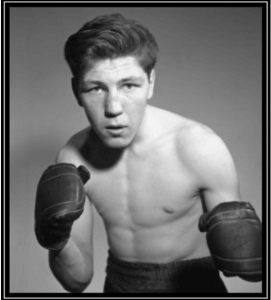
Joey Archer
Archer made his debut as an MSG headliner on Feb. 4, 1961, and had 12 more fights at the iconic mid-Manhattan sock palace over the next six years. The final two were world title fights with defending middleweight champion Emile Griffith.
Archer etched his name in the history books in November of 1965 in Pittsburgh where he won a comfortable 10-round decision over Sugar Ray Robinson, sending the greatest fighter of all time into retirement. (At age 45, Robinson was then far past his peak.)
Born and raised in the Bronx, Joey Archer was a cutie; a clever counter-puncher recognized for his defense and ultimately for his granite chin. His style was embedded in his DNA and reinforced by his mentors.
Early in his career, Archer was domiciled in Houston where he was handled by veteran trainer Bill Gore who was then working with world lightweight champion Joe Brown. Gore would ride into the Hall of Fame on the coattails of his most famous fighter, “Will-o’-the Wisp” Willie Pep. If Joey Archer had any thoughts of becoming a banger, Bill Gore would have disabused him of that notion.
In all honesty, Archer’s style would have been box office poison if he had been black. It helped immensely that he was a native New Yorker of Irish stock, albeit the Irish angle didn’t have as much pull as it had several decades earlier. But that observation may not be fair to Archer who was bypassed twice for world title fights after upsetting Hurricane Carter and Dick Tiger.
When he finally caught up with Emile Griffith, the former hat maker wasn’t quite the fighter he had been a few years earlier but Griffith, a two-time Fighter of the Year by The Ring magazine and the BWAA and a future first ballot Hall of Famer, was still a hard nut to crack.
Archer went 30 rounds with Griffith, losing two relatively tight decisions and then, although not quite 30 years old, called it quits. He finished 45-4 with 8 KOs and was reportedly never knocked down, yet alone stopped, while answering the bell for 365 rounds. In retirement, he ran two popular taverns with his older brother Jimmy Archer, a former boxer who was Joey’s trainer and manager late in Joey’s career.
May he rest in peace.
To comment on this story in the Fight Forum CLICK HERE
-
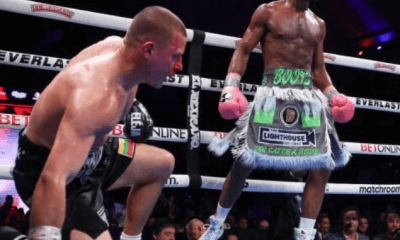
 Featured Articles4 weeks ago
Featured Articles4 weeks agoJaron ‘Boots’ Ennis Wins Welterweight Showdown in Atlantic City
-
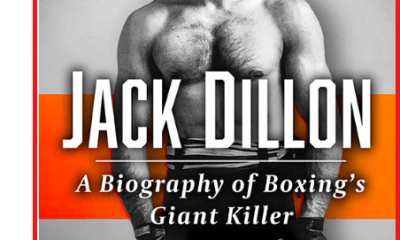
 Featured Articles4 weeks ago
Featured Articles4 weeks agoBoxing Notes and Nuggets from Thomas Hauser
-
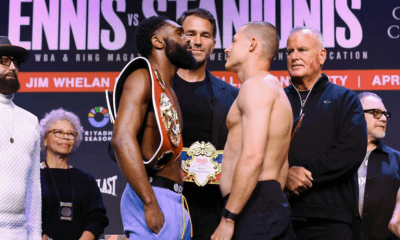
 Featured Articles4 weeks ago
Featured Articles4 weeks agoAvila Perspective Chap 320: Boots Ennis and Stanionis
-
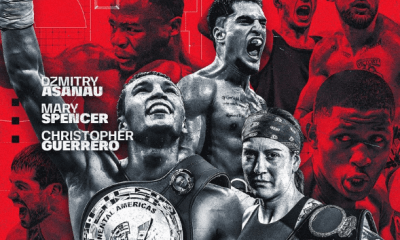
 Featured Articles4 weeks ago
Featured Articles4 weeks agoDzmitry Asanau Flummoxes Francesco Patera on a Ho-Hum Card in Montreal
-
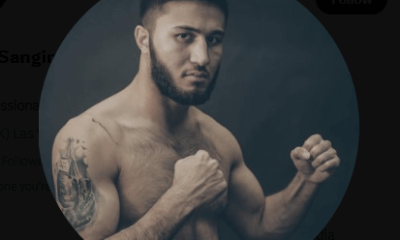
 Featured Articles3 weeks ago
Featured Articles3 weeks agoMekhrubon Sanginov, whose Heroism Nearly Proved Fatal, Returns on Saturday
-
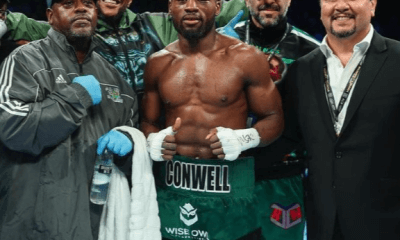
 Featured Articles3 weeks ago
Featured Articles3 weeks agoAvila Perspective, Chap. 322: Super Welterweight Week in SoCal
-
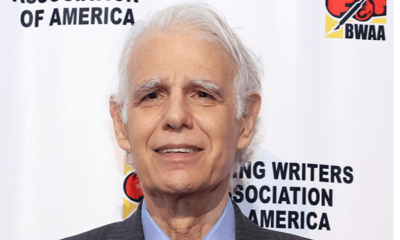
 Featured Articles3 weeks ago
Featured Articles3 weeks agoTSS Salutes Thomas Hauser and his Bernie Award Cohorts
-
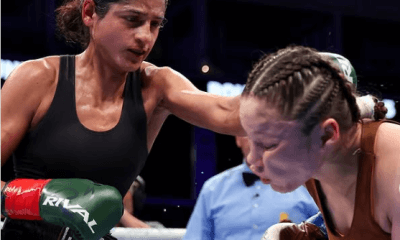
 Featured Articles3 weeks ago
Featured Articles3 weeks agoGabriela Fundora KOs Marilyn Badillo and Perez Upsets Conwell in Oceanside















